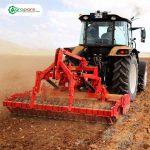Casting vs. Forging in Plowshare Production: Advantages & Disadvantages
Plowshares, essential components of plows, are produced using two primary methods: casting and forging. Each method has its own advantages and disadvantages and is chosen based on factors such as soil type, durability needs, and budget.
Casting Process
How It Works
In the casting process, molten steel is prepared and poured into special molds that define the final shape of the plowshare. Once the steel cools and solidifies, the cast piece is removed from the mold and undergoes finishing processes such as polishing and machining to achieve the final product.
Advantages of Casting
✅ Production of Complex Parts – Casting allows for the creation of intricate designs and varied shapes that would be difficult to achieve with forging.
✅ Lower Production Costs – The overall cost of casting is generally lower than that of forging, making it a cost-effective method for large-scale production.
✅ Suitable for Mass Production – Casting is ideal for high-volume production, allowing manufacturers to produce plowshares efficiently.
Disadvantages of Casting
❌ Lower Quality – Cast parts often have less structural integrity compared to forged parts.
❌ Porosity Issues – Cast plowshares may contain small holes or porosity, which can affect their strength and durability.
❌ Lower Impact and Wear Resistance – Due to their less dense structure, cast plowshares may have reduced resistance to impact and wear.
Forging Process
How It Works
In forging, steel is heated and shaped under high pressure using hammers or presses. This process increases the density and strength of the metal. After forging, the plowshare undergoes heat treatment and machining to achieve the desired final shape and durability.
Advantages of Forging
✅ Higher Quality – Forged plowshares are generally superior in strength and durability compared to cast plowshares.
✅ Greater Strength and Wear Resistance – The forging process increases metal density, making forged plowshares more resistant to impact and wear.
✅ Lower Porosity – Forged parts are denser and less prone to defects like porosity or air pockets, ensuring better durability.
Disadvantages of Forging
❌ Higher Production Cost – The cost of forging is typically higher due to labor intensity and energy requirements.
❌ Shape Limitations – Forging has design constraints, making it less suitable for complex or highly detailed shapes.
❌ Lower Production Volume – Unlike casting, forging is not as efficient for mass production due to longer processing times.
Which Method is Best for Producing Plowshares?
The choice between casting and forging depends on several factors, including soil type, working conditions, and budget:
- For Heavy and Hard Soils: 🌱 Forged plowshares are recommended as they offer greater strength, durability, and wear resistance in harsh agricultural conditions.
- For Soft and Light Soils: 🌾 Cast plowshares can be a cost-effective option as they do not require extreme strength and can be produced at a lower cost.
- For Budget-Conscious Operations: 💰 Casting is more economical, making it suitable for large-scale production where cost reduction is a priority.
- For Long-Term Durability: 🔨 Forging is the better choice, ensuring maximum durability and performance over time.
Both methods have their own applications, and the best choice depends on the specific farming environment and operational needs.






